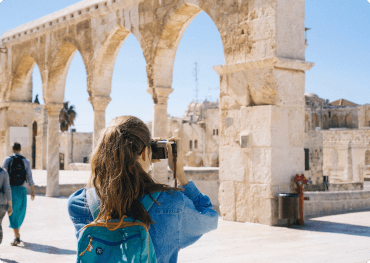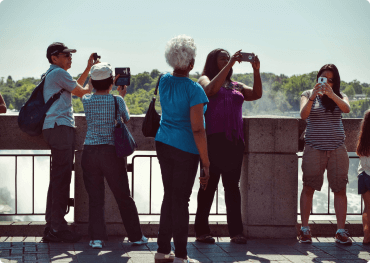
CL-503
Package Details
Day 1: Flight from your home country to Tehran capital of IRAN
We prepare ourselves for a fabulous trip to Great Persia.
Arrival to Tehran, after custom formality, meet and assist at airport and transfer to the Hotel.
Day 2: Tehran
After breakfast in hotel, we prepare to start for city sightseeing, visit Niyavaran Palace,
Lunch in a local restaurant during the visit .In the afternoon visit Bazaar Tajrish and Imamzadeh Saleh mausoleum.
Dinner in local restaurant and return to the hotel
The Niavaran Complex is a historical complex situated in Shemiran, Tehran (Greater Tehran), Iran. It consists of several buildings and monuments built in the Qajar and Pahlavi eras. The complex traces its origin to a garden in Niavaran region, which was used as a summer residence by Fath-Ali Shah of the Qajar Dynasty. A pavilion was built in the garden by the order of Naser ed Din Shah of the same dynasty, which was originally referred to as Niavaran House, and was later renamed Saheb Qaranie House. The pavilion of Ahmad Shah Qajarwas built in the late Qajar period.During the reign of the Pahlavi Dynasty, a modern built mansion named Niavaran House was built for the imperial family of Mohammad Reza Pahlavi. All of the peripheral buildings of the Saheb Qaranie House, with the exception of the Ahmad Shahi Pavilion, were demolished, and the buildings and structures of the present-day complex were built to the north of the Saheb Qaranie House. In the Pahlavi period, the Ahmad Shahi Pavilion served as an exhibition area for the presents from world eaders to the Iranian monarchs.
Imāmzādeh Sāleh is one of many Imāmzadeh mosques in Iran. The mosque is located at Tajrish Square in Tehran's northern Shemiran district. The mosque entombs the remains of Sāleh, a son of the Twelver Shī‘ah Imām, Mūsā al-Kādhim, and is one of the most popular Shī‘ah shrines in northern Tehran
O/N: Tehran.
Day 3: Tehran – Qazvin
After breakfast, check out hotel and drive to Qazvin (162km). In Qazvin visit Museum of Anthropology, Qajar bathroom,Tomb H. Exchequer, Cantor Church, Mosque of Qazvin, Qazvin market.
O/N: Qazvin
Museum of Anthropology: The monument in 1379 by the Cultural Heritage and Tourism Qazvin Province purchases and by investing Qazvin Municipality and the renovation and improvement of management was refurbished and now as the Museum of Anthropology in 3 parts ethnicities, customs and jobs are interested Bazdbd place.
Qajar bathroom: Bath Ghajar one of the oldest and largest bathhouses of Qazvin in 1057 AH by Amir Khan Qajar species Qazvini the commanders of Shah Abbas Safavi made Dstvrshah first "Royal Bath" is called. Building on the “Bless health, "said the 1057 is equivalent to:
Construction of elegance thanks to King bathroom ... to accept any MUQBIL
When one comes from the inside out ... "Bless the authenticity of" the date
Its area is about 1045 square meters. Bathroom of three main sections Srbynh, meandering and oven as well consist of two separate sections for men and women separately, in its original spiral staircase to the south opens and Srbynh leads. Srbynh large bath with beautiful pond in the middle of it six alcove arch and octagonal in plain view with a corridor to link the oven.
Tomb H. Exchequer: Tomb H. Exchequer of the patriarch and Qazvin, Taleghani Street, Street Malekabad former alley located Exchequer and the effect on 20 Persian date Bahman 1318 with registration number 332 as one of the national monuments has been registered. H. Exchequer small brick tomb tower is planned lunar eighth century square tower capped by four elephants, 8-sided and covered with conical dome.
280 square meter courtyard is only 40 square meters of this amount is allocated to infrastructure. Entrance to the tomb of the Prophet Mohammad Sadiq including La Illaha Alaallh ol Haq and Al-Bari al-Amin al- decorated, the building has a simple turquoise tiled domes and pillars around the inscription is below Sura pushed further down the line prescriptions bed and double doors at the entrance the tomb also sloppy goal is inlaid.
A pair of inlaid tomb, a leaf is gone and the door has been transferred to the National Museum of Iran and its location in the new building was laid in the tomb.
Exterior brick building in accordance with the provisions of the patriarch M's style, conical dome earlier that in later period’s brick and tile Mqrnssazy circle around the bottom of the dome repaired.
Infrastructure and the beautiful dome of the magnificent monuments of the Mughal era, with an inscription in hieroglyphics how life is azure tiles H. Exchequer, ancestors and his writings have been summarized.
The tombs in the neighborhood of the Shrine of Ali and Amna Khatoon cotton thread Square East is located in Qazvin, which is also called long-Dome.
Many people in the fourteenth century solar neighborhood, enclosure wall around the monument that had become ruins, were conducted at the tomb of a brief but historic restoration in 1319 this tomb was essential.
The entrance on the southwest side of the mausoleum is across the courtyard and shape of the tiles to square up above the 8-sided and the rest of the jugular subrounded, the dome of cone-shaped and all the brick distances be jointing is.
North corner, two bedrooms and two underground mausoleum to guard the tomb was built with a dock and water. The tomb in the style of Azerbaijani architecture is built.
Cantor Church: Cantor Church known as the "bell tower" in World War II during the occupation of Iran by Russian forces in the city of Qazvin was built. This chapel like other church has a cruciform plan, with the altar facing east. West Drzl the church entrance and includes entrance space with sloping roof and entrance doors. After logging in, the Hall space located at the top of the belfry with a height of about eleven meters to be seen. Hall includes a chapel and altar, and on both sides, are two rectangular space. Altar space in the shape of a half circle and over the dome is located. Prayer hall with a dome and side spaces covered beds. The exterior of the church, decorative columns can be seen. Church architecture irregular polygon map is glazed with red brick and has a great view. Decorative columns on the exterior of the church is beautiful and there are special because of the shape and contour of the Church among the monuments of Qazvin has a very different position. Edges first floor of the bell tower of the chapel has great views, but on the second floor Burch column four columns in the four corners of the distance from the wall. Apart from Tvrgyrhay chapel bell
Tower is also Nvrgyrhayy. Pave the churchyard has been seen in the area where stone is one of them belongs to a Russian pilot.
Mosque of Qazvin: Atiq Mosque of Qazvin or Mosque or the Great Mosque of the largest mosques in Iran and most Vkhn Msjdjam Iran from the time of Sassanid fire temple was built on the first Ast.bnay (temple was part of the southern portico). It has four porches and the style Msjdbh the city of Qazvin. This year 192 AD, built at the command of Aaron Alrshydvbh. The Mongol invasions of Qazvin Vazanjakh the Msjdshhrbvdh, part of it (Vazjmlh south porch) was destroyed but has been restored in subsequent periods.
Multi-era architecture in the oldest part of the building is observed and it belongs to the second century of Islam. Ivan course Safavi renovated but the eastern porch during the Qajar been refurbished.
Construction Mqsvrh Khomartash on the south side of the mosque on the orders of the Emir Ibn Abdullah Emadi hooded Tash, Minister Sultan Malek Shah Seljuk was the year 500 AH. As well as the inscriptions on the fifth row of flowering Kufic script, manuscripts and one-third can be seen at this location.
In May 1392 Cultural Heritage, Handicrafts and Tourism Organization of Qazvin province west of the restoration of the minaret of the mosque Museum of stone and ceramics in the yard opened west of the historic mosque. The museum of pottery, stone engravings, sash, tile and various gypsum involved in the art exhibit in the world.
Qazvin market: Qazvin collection with interesting architecture and its old market, one of the landmarks of the city of Qazvin Ast.sabqh market in Qazvin to one thousand years, and over time the market reaches up to the Safavid grows and in the course by selecting Qazvin as the capital of Iran and after in the Qajar era with the construction of significant projects such as the home of Saad al- market due to the proximity of the city of Qazvin in the axis connecting the capital of the west and northern Iran on those given great value. But the current market collection of Safavid and attributed much of its current buildings during the Qajar made.
During the Safavid expanded market environment and the market have been related to a specific trade. In the course of each of these markets, mosques, baths, inns, arcade and Qysryhhay that of these, arcade and Caesarea Trade Center site were craftsmen. Qazvin housed Taqha brick immense height, Yi sections of Qazvin market, which has four gates and is still extant works. North Door Timcheh soldier, southern door Timcheh covered, Eastern door to the home minister and the Western door to a small Chahar connected.
Qazvin's most important market areas are: un-Nabi (mosque) , Saad al-Saray , the home secretary , the home of Haj Reza Razavi House (the home of the King), covered passageways including indoor and outdoor swimming Mehdi Darvish, Haj Mohammad Taqi and orders Caesarea.
Day 4: Qazvin – Zanjan
After breakfast, check out hotel and drive to Zanjan (177km), in the way Dome of Soltaniyeh. Arrival to Zanjan, visit tourist attraction Zanjan market, a laundry, Jameh Mosque, salt men museum.
O/N: Zanjan
Zanjan province is one of Iran's provinces in northwest Iran in the world. The capital city of Zanjan is. 8 is a city of Zanjan province and 1210 villages of these, 978 villages with inhabitants and the rest are uninhabited.
Dome of Soltaniyeh: The central magnet of Soltaniyeh's several ruins is the Mausoleum of Il-khan Öljeitü also known as Muhammad Khodabandeh, traditionally known as the Dome of Soltaniyeh in Soltaniyeh city, Zanjan Province. Olcaytu Xudabəndə türbəsinin kəsiyi-001.jpg
The structure, erected from 1302 to 1312 AD, has the oldest double-shell dome in Iran. This erroneous view of the construction was made by Dieulafoy but is totally disputed by Andre Godard. In Godard's view it is a normal, if spectacularly large dome, with a thin skin on top for the faience and is in no way a double dome. Its importance in the Muslim world may be compared to that of Brunelleschi's cupola for Christian architecture. It is one of the largest brick domes in the world, just at the theoretical engineering limit for a brick dome and the third largest dome in the world after the domes of Florence Cathedral and Hagia Sophia. The Dome of Soltaniyeh paved the way for more daring Iranian-style cupola constructions in the Muslim world, such as the Mausoleum of Khoja Ahmed Yasavi and the Taj Mahal. Much of its exterior decoration has been lost, but the interior retains superb mosaics, faience, and murals. People have described the architecture of the building as “anticipating the Taj Mahal.”
The estimated 200 ton dome stands 49 meters (161 ft.) tall from its base, and is currently undergoing extensive renovation.
Zanjan market during the Agha Mohammad Khan Qajar began in 1213 at the time of Fath Ali Shah Qajar terminated and mosques, inns and public baths were added in 1324. Complex market as the market older for a straight line up and down to two divided east and west. Geographical extent and diversity of Zanjan market, the number of inns and Kavansrahay in the city of sub-orders, each dedicated to a specific activity and a name and indicate the dynamics of the series during earlier times and many mosques conditions prevailed. The market's longest indoor market spread from the West and East and therefore a down market and high market share and has been named.
Construction of Zanjan market in 1205 AD during the reign of Qajar Ghamhmd the beginning of the year 1213 AH coincides rule of Fath Ali Shah Qajar has ended. In later periods to the building of Zanjan market, including the construction of several Serra, mosques, and bath houses added.
Laundry or laundry historical building in the heart of the historic fabric of the city of Zanjan which is based on the old city wall, in a densely populated residential area was built. People in uniform and his clothes in the place Myshsthand. Such is not the same user for a public monument or is rare in the world. It has now been repaired and the Museum of Anthropology is used and people can visit it. The building in recent years due to the cold weather in winter Zanjani was created for women. Laundry, Zanjan monument at the site known as Baba Jamal Chvqvry (pit Babajmal) is located in the heart of the historic fabric of the city and access to laundry building from the street by street culture Saadi is also possible.
The purpose of this laundry, security and comfort women was in an indoor location.
The similarity between the users of these materials in any part of the country has not seen in this way, but in terms of architecture Abasgholi Khan Mosque and Citadel gate comparable to the building and public works day and night for its use Nmyshdhast received any money from citizens.
Laundry building Zanjan province is now the most important museums in various costumes, accessories, tools and equipment used in women have been exposed.
Zanjan comprehensive school and mosque known as the Mosque of Sayed in the thirteenth century AH (in 1242) during the Qajar by a son of Fath Ali Shah Qajar in the name of Abdullah Mirza has disciples of Ayatollah Seyyed Mohammad priest Srdany was built to the center of teaching, prayer and the priest is the people's recourse Zanjani. House Hosseini Zanjani has since trustee of the mosque are responsible. The mosque is in the heart of the old city and is located in a good place in terms of access, from the Bakhtar housed, from the east and from the north alley of Sayyid Mosque Imam Khomeini Avenue and Green Square is related. The mosque named Masjid during the life of its founder, Seyyed Mosque, also called the Friday Mosque Masjid Sultan and laid. This historic collection that is among the largest and most beautiful mosques and religious schools in Zanjan, a valuable building of the mosque has four porches is made according to plan. Ayvanhay the four symmetrically placed on four sides of the mosque, more than anything in the courtyard of the mosque, glaring. Like other mosques in the courtyard of the mosque has four porches, square and rectangular shaped and 48 meters long and 36 meters wide.
In the middle of the courtyard of the mosque was a single pool that encircles it with the exception of the cells and Shbstanha, flowery gardens and plant cover that later disappeared absurd reasons. In Ayvanhay eastern and western 16 symmetrically rooms and 6 single rooms on the north side of seminary students were also made. In North and South Ayvanhay levels decorations such as building line, tiles and paintings Mqly herbal technique of polychrome tiles, Qajar art style and more with black and yellow colors to be seen. Domed prayer hall space width 7. 90 m and length of 8. 50 meters that is located immediately behind the south porch of the west and east and from north to south porch with Shbstanhay parties in the relationship. Over the yard, a huge dome on heavy Jrz · hay thickness of 20. 30 m based Grdydhast. Double-glazed dome of the mosque is covered with turquoise tiles, the domes that without earrings and Trnbh on four thick boat Jrz · hay. Sura Aldhr third line painted on the dome and added to its beauty. In the top of the dome, there are signs of bronze in the shape of balls.Hosseini library is located on the upper floor of the mosque.
Men salt the name given to six mummies discovered in the winter of 1372 (1993 AD) in mining salt Chehr abad province was given. Among them was the body of a woman and a teenage boy there. A number of men of working salt mine with a bulldozer, severely damaged. In 2008, the mine ceased operation due to lack of Sixth Salt Man's body for maintenance of the mine remained intact.
Among men found salt, salt three men at the time of the Achaemenids (400 BC) and two other rooms of the late Sassanid (400 to 600 AD) are.
Day 5: Zanjan – Tehran
After breakfast, check out hotel and drive toward Tehran. Transfer to International airport to fly back to your home.
Details
Pellentesque accumsan magna in augue sagittis, non fringilla eros molestie. Sed feugiat mi nec ex vehicula, nec vestibulum orci semper. Class aptent taciti sociosqu ad litora torquent per conubia nostra, per inceptos himenaeos. Donec tristique commodo fringilla. Duis aliquet varius mauris eget rutrum. Nullam sit amet justo consequat, bibendum orci in, convallis enim. Proin convallis neque viverra finibus cursus. Mauris lacinia lacinia erat in finibus.
Pellentesque accumsan magna in augue sagittis, non fringilla eros molestie. Sed feugiat mi nec ex vehicula, nec vestibulum orci semper. Class aptent taciti sociosqu ad litora torquent per conubia nostra, per inceptos himenaeos. Donec tristique commodo fringilla.
- Specilaized Bilingual Guide
- Private Transport
- Entrance Fees
- Box Lunch,Water,Dinner and Snacks
Pellentesque accumsan magna in augue sagittis, non fringilla eros molestie. Sed feugiat mi nec ex vehicula, nec vestibulum orci semper. Class aptent taciti sociosqu ad litora torquent per conubia nostra, per inceptos himenaeos. Donec tristique commodo fringilla.
- Specilaized Bilingual Guide
- Private Transport
- Entrance Fees
- Box Lunch,Water,Dinner and Snacks
Pellentesque accumsan magna in augue sagittis, non fringilla eros molestie. Sed feugiat mi nec ex vehicula, nec vestibulum orci semper. Class aptent taciti sociosqu ad litora torquent per conubia nostra, per inceptos himenaeos. Donec tristique commodo fringilla.
- Specilaized Bilingual Guide
- Private Transport
- Entrance Fees
- Box Lunch,Water,Dinner and Snacks
Pellentesque accumsan magna in augue sagittis, non fringilla eros molestie. Sed feugiat mi nec ex vehicula, nec vestibulum orci semper. Class aptent taciti sociosqu ad litora torquent per conubia nostra, per inceptos himenaeos. Donec tristique commodo fringilla.
- Specilaized Bilingual Guide
- Private Transport
- Entrance Fees
- Box Lunch,Water,Dinner and Snacks
Pellentesque accumsan magna in augue sagittis, non fringilla eros molestie. Sed feugiat mi nec ex vehicula, nec vestibulum orci semper. Class aptent taciti sociosqu ad litora torquent per conubia nostra, per inceptos himenaeos. Donec tristique commodo fringilla.
- Specilaized Bilingual Guide
- Private Transport
- Entrance Fees
- Box Lunch,Water,Dinner and Snacks






















